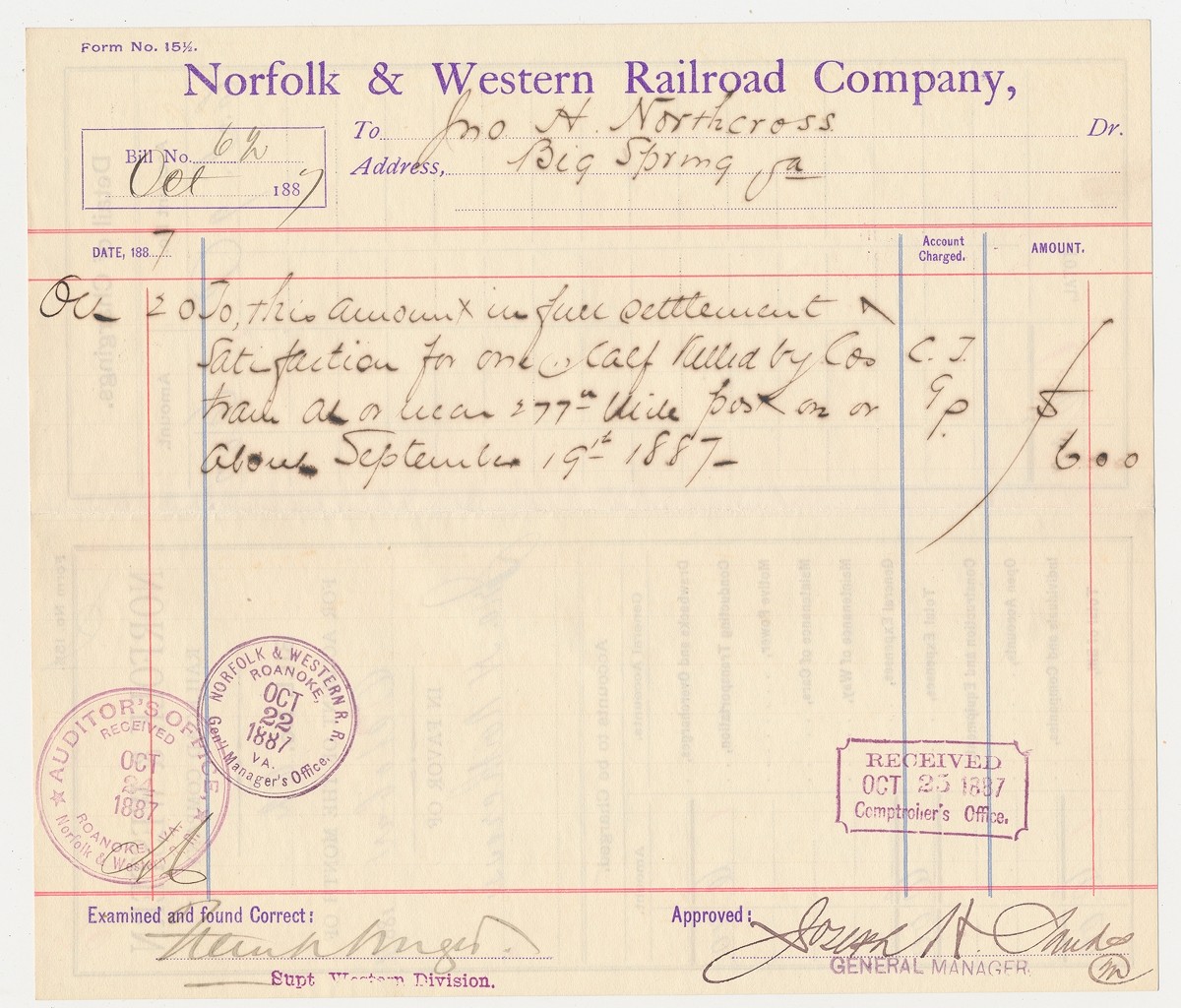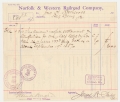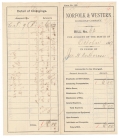site search
online catalog
POSTWAR RAILROAD DOCUMENT SIGNED BY CONFEDERATE ARTILLERYMAN FRANK HUGER

$60.00 SOLD
Quantity Available: None
Item Code: 1054-2286
Document is a Norfolk & Western Railroad Company bill dated October 1887 and signed at bottom by Frank Huger as Superintendent of the Western Division. Signature is in strong period pencil.
Francis (Frank) Kinloch Huger, a son of Benjamin Huger and Elizabeth Celestine Pinckney, was born in Norfolk, Virginia in 1837. Like his father, Huger attended the United States Military Academy at West Point. He graduated in 1860 and was assigned to the 10th U.S. Infantry as a second lieutenant. Huger resigned his commission on May 21, 1861 to join the Confederate cause.
Commissioned a captain in the Confederate army, Huger led the Norfolk Light Artillery. The battery was attached to the brigade of Brig. Gen. Ambrose R. Wright in the Seven Days Battles. At the Second Battle of Bull Run and the Battle of Fredericksburg his battery was attached to the division of Maj. Gen. Richard H. Anderson. Huger was absent from the Battle of Antietam, when his battery was led by Lt. C. R. Phelps.
Huger was promoted to major on March 2, 1863. At first, he was second in command of a battalion of artillery led by Col. Edward Porter Alexander. Alexander welcomed Huger, describing him later as "my glorious & beloved Frank Huger, who never shirked a care or danger or grumbled over a hardship in his life..." In that capacity, Huger served in the Battle of Chancellorsville, including bombarding federal lines from high ground at Hazel Grove on May 3, 1863. On May 4 he was sent to support the division of Maj. Gen. Richard H. Anderson in the Battle of Salem Church. His guns were among those that fired the last shots of the battle the next day, as the Union VI Corps retreated across the Rappahannock River. At the Battle of Gettysburg, Huger was involved in supporting the attack of Lt. Gen. James Longstreet's corps on the federal left on July 2. During July 3 Huger took immediate command of the guns as Alexander was assigned responsibility for the bombardment preceding Pickett's Charge.
After Gettysburg Huger went West with Longstreet's Corps, but he arrived too late for the Battle of Chickamauga. When Longstreet moved into eastern Tennessee to evict federal forces, Alexander served as his chief of artillery. Huger consequently commanded Alexander’s battalion in the Knoxville Campaign. When Alexander became the permanent chief of corps artillery in late 1863, Huger officially took over command of the battalion. He rose to the rank of lieutenant colonel shortly thereafter, being promoted on February 27, 1864.
Huger's battalion served in the Overland Campaign and the Siege of Petersburg. In Alexander’s absence, he was temporarily in charge of the artillery of the First Corps posted near Elliott's Salient at the time of the Battle of the Crater. At the height of the Union attack on July 30, 1864, following the explosion of the mine under the Salient, Huger was seen helping work a gun along with members of Alexander's staff. Huger was promoted to the rank of colonel on February 18, 1865 and was captured during the Battle of Sailors' Creek by Union cavalry led by Brig. Gen. George A. Custer, a fellow West Point graduate (Class of 1861). Huger was treated by Custer more like a guest than a prisoner.
After the war Huger worked for the Norfolk & Western Railroad Company. He died in Roanoke, Virginia on June 10, 1897 and is buried in Spring Hill Cemetery in Lynchburg, Virginia. [ad]
~~~~~~~~~~~~~~~~~~~~~~~~~~~~~~~~~~~
THIS ITEM, AS WITH ALL OTHER ITEMS AVAILABLE ON OUR WEB SITE,
MAY BE PURCHASED THROUGH OUR LAYAWAY PROGRAM.
FOR OUR POLICIES AND TERMS,
CLICK ON ‘CONTACT US’ AT THE TOP OF ANY PAGE ON THE SITE,
THEN ON ‘LAYAWAY POLICY’.
THANK YOU!
Inquire About POSTWAR RAILROAD DOCUMENT SIGNED BY CONFEDERATE ARTILLERYMAN FRANK HUGER
For inquiries, please email us at [email protected]
Most Popular
Historical Firearms Stolen From The National Civil War Museum In Harrisburg, Pa »
Theft From Gravesite Of Gen. John Reynolds »
Cavalry Carbine Sling Swivel »
Fine Condition Brass Infantry Bugle Insignia »
featured item
EARLY WAR U.S. CAVALRY OFFICER’S SABER, 1840 STYLE, BY SMITH, CRANE AND COMPANY, NEW YORK, 1858 TO 1862
Smith, Crane and Company pieces are scarce. They were only in business from 1858 through 1862, retailing military goods in New York City. Their swords were imported, of German make and likely by Schnitzler and Kirschbaum, though not maker marked.… (870-263). Learn More »





